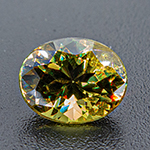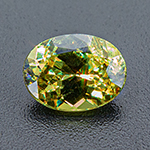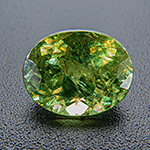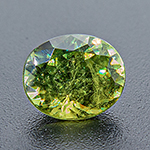Demantoid Garnet
Geen Andradite garnet, member of "Ugrandite" (uwarowite, grossular, andradit) group (see "Garnet")




Demantoids from Namibia
Demantoid shop
Origin of name: named by Finnish mineralogist Nils Gustaf Nordenskiöld, who first identified the gem as green andradite. The term demantoid derives from Middle Low German demant for diamond and actually means diamond-like.
Demantoid owes it´s diamond-like appearance to the high refractive index and dispersion ("fire"). In fact the dispersion of demantoid is substantially higher than that of diamond. However, the "fire", i.e. the play of colour seen when moving the stone, is partly masked by the demantoid´s body color.
Synonyms and trade names: for many years demantoid was persistently and misleadingly called "olivine" by the trade, which actually is the mineralogical name for peridot. To avoid further confusion, gemmologists nowadays disuse the term olivine even in its correct context.
Can be confused with: other green gems like peridot and verdelite (green tourmaline)
Localities: the most important localities were in Russia (Nizhniy Tagilsk, Sissertsk district and along Bobrovska river). Today (2021) the most productive and commercially important localities are in Erongo region, Namibia. Other less important sources are Iran, Madagascar, Eritrea, Sri Lanka, Mexico, the USA and Lombardy in Italy
Handling: demantoid is relatively soft and rather brittle. Set with care! Sensitive to acid and heat. No ultrasonic cleaning, no electroplating!
Worth knowing: Russian demantoids often contain fibrous inclusions of chrysotile asbestos and actinolite asbestos. The fibres often originate from a black chromite crystal and bear some resemblance to a horse-tail.
These horse-tail inclusions are typical for Russian demantoid. They were also observed in Italian and Eritrean stones but so far not in Namibian demantoid.
Demantoids with pronounced horse-tail inclusions are highly sought after by collectors and garnet connoisseurs. Contrary to inclusions in most other gems, horse-tails in demantoid may raise the gem´s value despite the detrimental effect to its brilliance.
 Deutsch
Deutsch